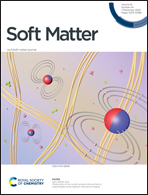Effect of polyampholyte net charge on complex coacervation between polyampholytes and inorganic polyoxometalate giant anions†
Abstract
The effect of net charge of zwitterionic polymers on the phase behavior and viscoelastic properties of hybrid polyampholyte–polyoxometalate (POM) complexes in salted aqueous solutions is investigated with polyampholyte copolymers consisting of both positively and negatively charged monomers. Zwitterionic polyampholytes of varied net charge, abbreviated as PAxMy, are synthesized by varying the feeding molar ratio of negatively charged 2-acrylamido-2-methyl-1-propanesulfonic acid (AMPS) to positively charged [3-(methacryloylamino)propyl]trimethylammonium chloride (MAPTAC) monomers in aqueous solution. The coacervate formation between PAxMy and inorganic anionic metatungstate POM ({W12}) in LiCl added aqueous solutions can be enhanced by increasing the molar fraction of positively charged MAPTAC monomer and LiCl concentration. The salt-broadened coacervation, clearly distinct from the salt-suppressed one between oppositely charged polyelectrolytes, suggests the account of zwitterion-anion pairing for PAxMy–{W12} coacervate formation due to stronger binding of multivalent {W12} giant ions with PAxMy than simple ions. Importantly, as AMPS or MAPTAC monomer fraction in polyampholytes is varied by merely ±5% from the effective net neutral case, the viscoelasticity of PAxMy–{W12} coacervates can be modified by 4–5 folds, suggesting a new tuning parameter to fine control the macroionic interactions and material properties of biomimetic complex coacervates.



 Please wait while we load your content...
Please wait while we load your content...